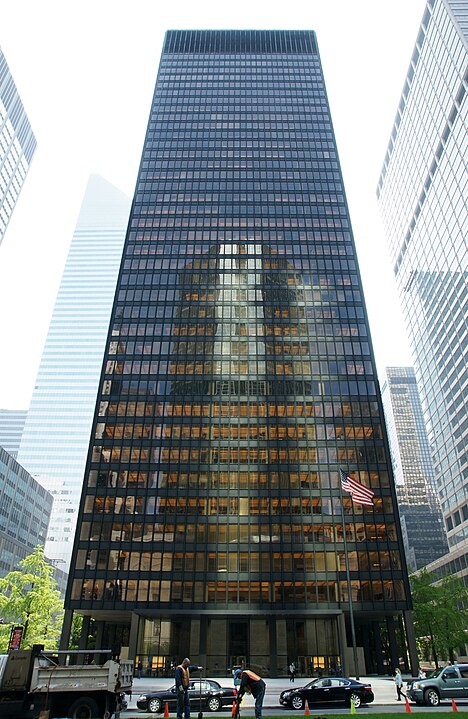Home to over 6,000 high-rise buildings, these corporate structures are part of New York’s fabulous history. One of which is the landmarked Seagram Building that towers on 375 Avenue between 52nd and 53rd streets. Opened in 1958, the 38-story skyscraper is often regarded as one of the prime icons of functionalist aesthetics, innovative construction, and modernism, setting the standard for many of the famous corporate offices we have today. Here, let’s discover how the Seagram Building came into existence and how it changed the landscape of architecture in the United States forever.
Conception
Following the prohibition of alcohol in 1933, Samuel Bronfman, Seagram Distillers CEO, aimed to build a huge headquarters in Manhattan, specifically between the 50th and 59th streets of Park Avenue, which was booming in commercialism. In 1951, it bought the 4,733 square meter lot on its current location for $4 million. Three years later, in July 1954, the company declared the construction of the 34-story skyscraper under Pereira & Luckman, the architectural firm behind the iconic Lever House, which was just right across the planned Seagram Building.
Initial plans were to build a four-story base made of bronze and marble then topped by a 30-story structure. Various plans were submitted by the firm to NYC’s Department of Buildings within the same month, estimating it to be completed in 1957, in time for Seagram’s centennial anniversary.
Discover more famous museums in the Big Apple as we count the buildings in the city. Visit Unveiling the Skyline – Counting the Buildings of New York City.
Shifting Plans
Odds didn’t go in favor of Pereira & Luckman, though. Their design raised eyebrows, with critics saying their planned building resembled a trophy or a huge cigarette lighter. Bronfman’s daughter, Phyllis Lambert, was displeased when she saw the proposal and rendering of the design. Situated in Paris, she wrote to her father in August about her disapproval, claiming that their company’s headquarters should also bring value to New York City, apart from being an insignia of Seagram.
Bronfman gave way and allowed Lambert to look for a backup architect. Though the design from Pereira & Luckman was still publicized as the lead-in plan for the building. Many media personalities deemed that the scheme was already cast off.
Meanwhile, Lambert came across Museum of Modern Art’s director Philip Johnson, who then advised her to screen and interview various Modernist architects. In November 1954, German architect Mies van der Rohe was selected to spearhead the building’s plan. Aiming for a simple slab, Mies, as he is commonly referred to, chose to have a 5-by-3-bay rectangle design, which earned Lambert’s approval and admiration.
Construction
In March 1955, updated designs from Mies were submitted to the DOB, increasing the estimated cost to $20 million. Demolition of existing structures on the property later that year and was finished in March 1956. Construction formally began in May 1956, and the following month, it saw the installation of its first major steel column. Around 700 workers worked together, fitting the steelwork that weighed about 12,500 tons and composed of 5,000 individual pieces. Lambert was pretty keen on following Mies’ original design, instructing the builders to adhere even to the slightest details. Its base was completed in December 1956, facade work in April 1957, then officially opened on May 22, 1958.
Design
After its completion, it’s no surprise that the Seagram Building quickly catapulted into popularity. Mies’ design shattered the traditional use of heavy stone and brick facades by combining sleek glass and metal, ushering in a new era of functional architecture blended with elegance and modernism.
Inside, it used modern materials and a well-arranged steel skeleton which gave the building supreme stability. Outside, it boasts a stunning minimalist, sophisticated styling using full-height plate glass windows with extruded bronze facades, which is from the plain-looking buildings of its time. Indeed, it was a dignified masterpiece that was genuinely eye-catching and soon became an international standard.
Seagram Building Through The Years
The Seagram occupied part of the office space in its opening while allowing the rest to be rented out. About two months later, the Seagram Building was almost full, having 90% of its spaces leased. Some of the first occupants of the building’s elegantly designed spaces were Maruzen Oil, Bethlehem Steel, Eagle Pencil, Goodson-Todman Productions, and other corporations from different sectors. Two years later, Seagram Building was fully occupied and had a waiting list for aspiring occupants.
In 1963, the New York City government awarded Seagram Distillers for the structure’s “notable contribution” to NYC. With its prominence, the company received various offers from potential buyers during the 1970s. They decided to keep their ownership of the then internationally-acclaimed structure, which they announced publicly in 1976.
Three years later, however, Seagram declared they’ll be selling the company at $75 million, with a mandate that the buys must preserve the public spaces and exterior of the building. Teachers Insurance and Annuity Association purchased the building in June 1979 for $85.5 million.
In 1988, with the Seagram Building already reaching the required thirty-year age, the TIAA applied for the landmark status of the building’s exterior, lobby, and plaza, which was then granted on October 3, 1989. Seagram Building was sold to real estate investor Aby Rosen’s RFR Holding in December 2020 was again mandated to keep its iconic facade in its near-pristine condition.
In February 2006, the Seagram Building was listed to the National Register of Historic Places due to its significant contribution to the city, being a marvel of architecture, structural engineering, and being the face of modern corporate identity.
Final Words
Today, the Seagram Building is still celebrated as one of the 20th century’s most significant skyscrapers. A consistent subject of much study and scrutiny due to its prominent legacy, New York’s skyline may have been entirely different without this famed and iconic building.

